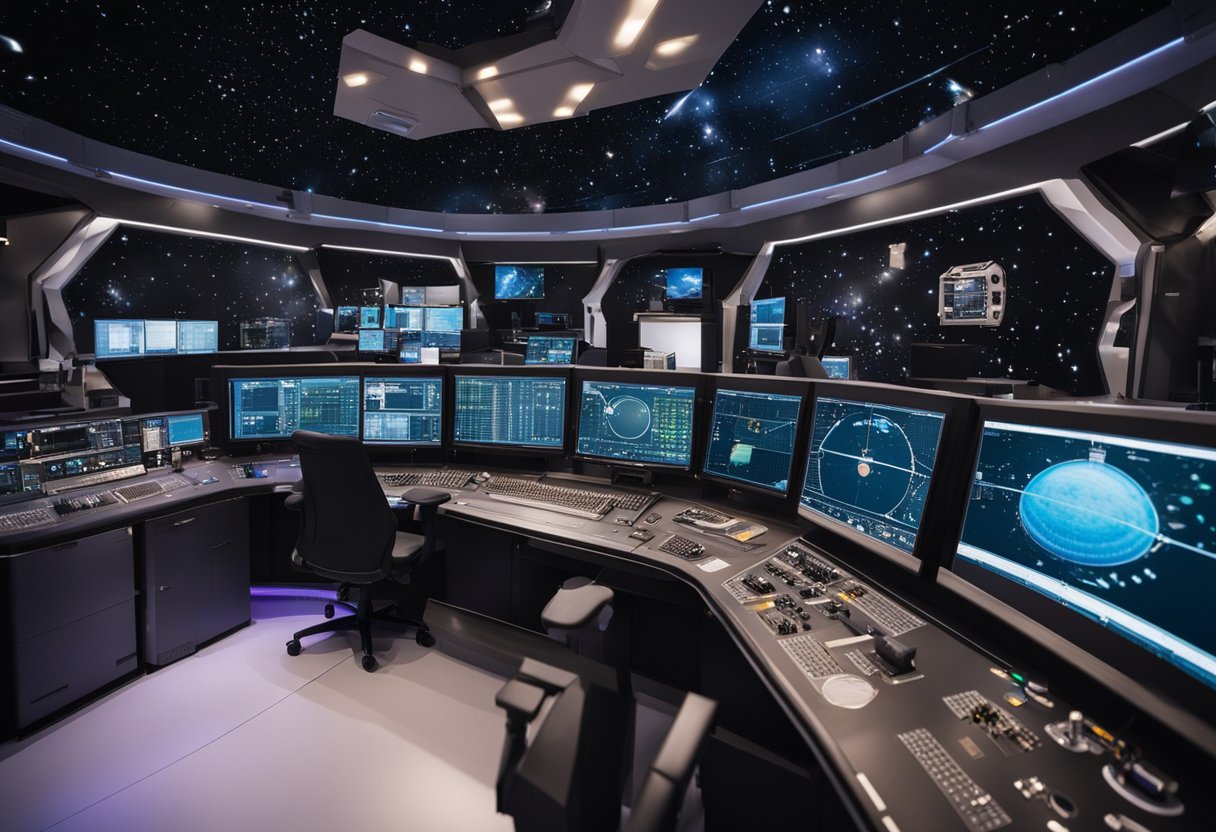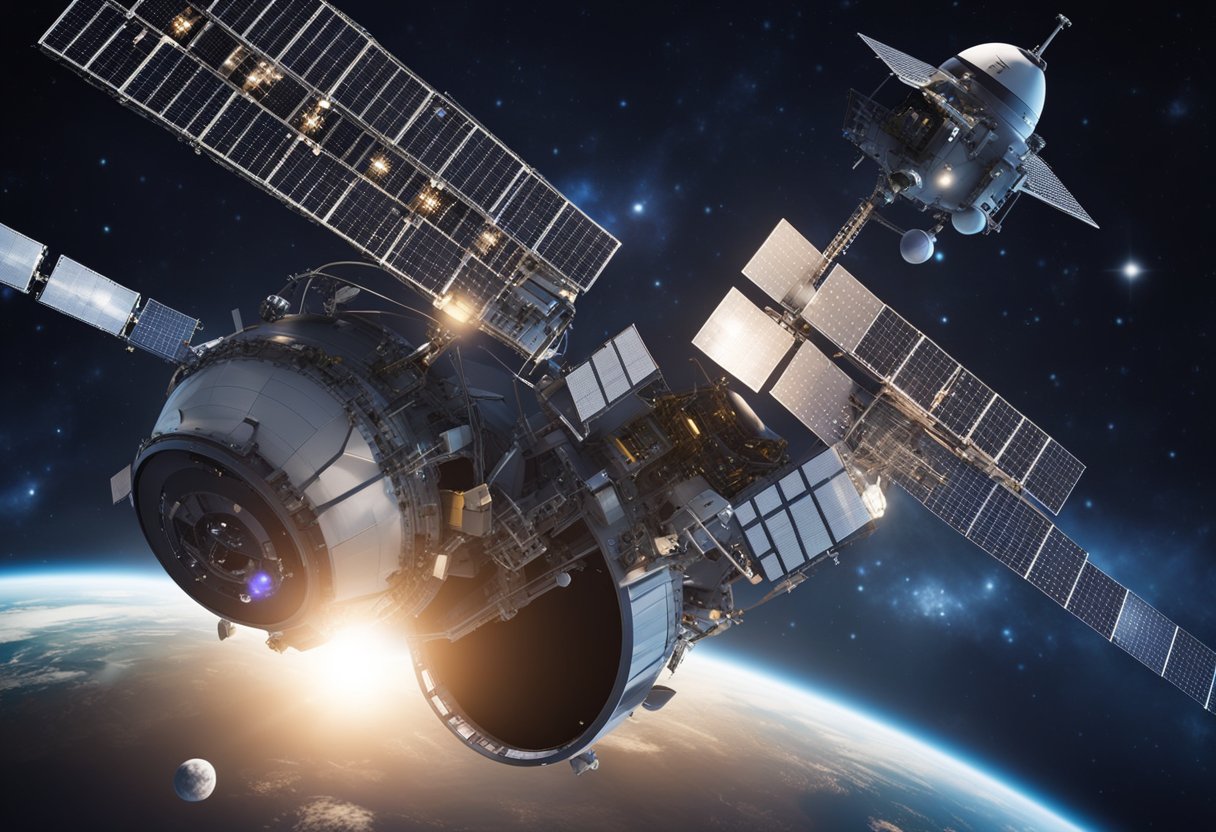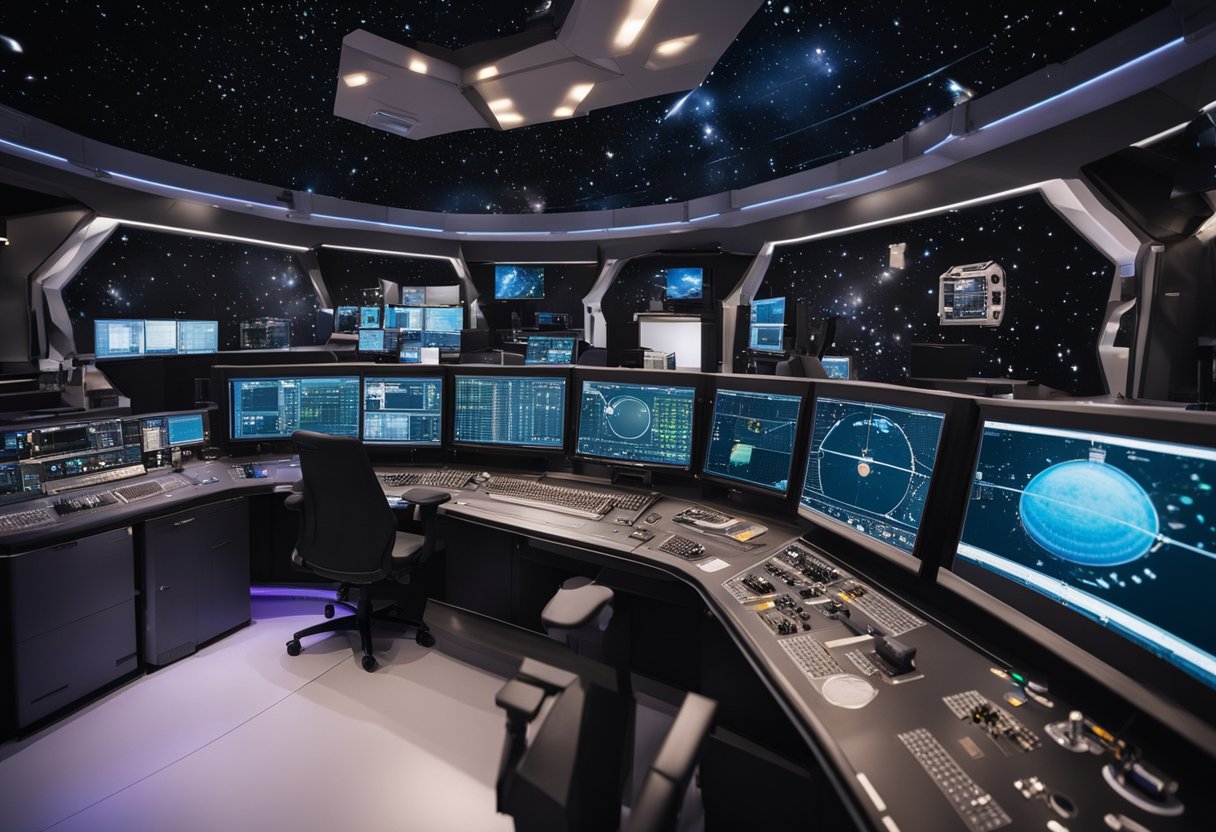
Spacecraft communication systems are integral to space exploration and satellite operations, enabling the collection and transmission of data across vast interplanetary distances. Sending commands, receiving data, and tracking spacecraft are all functions that hinge upon robust communications infrastructure. Throughout history, these systems have evolved tremendously, with early missions utilising relatively simple radio frequency systems to contemporary missions that implement complex networks, such as NASA’s Deep Space Network. Ground stations and space communications satellites work in concert to maintain a constant link with orbiting and interplanetary spacecraft.

Despite the advances in technology, communicating with spacecraft presents unique challenges. The vastness of space means signals often travel long distances, making them susceptible to loss of strength, thus requiring very sensitive receiving systems on Earth. Moreover, spacecraft must be equipped with navigational capabilities to ensure accurate data transmission and coverage across various parts of the solar system. In addition to radio waves, optical communication in space is an emerging technology, potentially providing faster data rates than traditional radio frequency systems.

The evolution of spacecraft communication systems has been pivotal in expanding our reach into space. It began with early beacons like the Echo satellites, which were passive communication reflectors rather than active repeaters. Following this, Telstar 1 emerged as a significant milestone, launching on July 10, 1962, and successfully relaying the first transatlantic television signals. This endeavour demonstrated the feasibility of satellite communications (Satellite communication).
In the establishment of NASA in 1958, we saw a dedicated effort to advance satellite communication technologies. The creation of NASA’s Deep Space Network (DSN), managed by the Jet Propulsion Laboratory, bolstered deep space communication, allowing for an uninterrupted link with interplanetary spacecraft.
The DSN consists of three facilities strategically dispersed around the globe:
This configuration enables constant observation of spacecraft as Earth rotates, ensuring a continuous flow of data and commands (50 Years of Communications in Space).
Spacecraft communication has dramatically enhanced, moving from simple bounce-off techniques to intricate systems involving space antennas and receivers that manage both uplink and downlink of signals. Nowadays, communication systems are a sophisticated array of ground-based and space-borne apparatus, indispensable for missions operated by us at NASA and commercial enterprises venturing into space travel and tourism, such as those listed on SpaceVoyageVentures.com.
Space communication technologies will keep evolving, adapting to the challenges presented by deep space exploration and supporting the infrastructural needs of burgeoning space tourism.
In space communications, we transmit and receive signals across the vastness of space, connecting spacecraft to Earth and other celestial bodies. The cornerstone of this process is the utilisation of electromagnetic waves, primarily radio waves, to carry information over immense distances.
Our discussion includes key elements such as:
When discussing frequencies, we encounter bandwidth and frequency bands:
Modulation plays a pivotal role as well:
Lastly, data rate is a measure of how much information we can transmit in a given amount of time, directly influenced by the bandwidth and modulation scheme employed in the communication system.
By mastering these fundamentals, we pave the way for successful connectivity with spacecraft, ensuring that our missions are both achievable and productive.
Essential to all space missions are the communication systems on board spacecraft, without which none of the vital data and controls can be relayed between Earth and the spacecraft. These systems are composed of sophisticated hardware designed to operate in the harsh conditions of space.
Antennas, the pivotal elements in space communication, are responsible for sending signals over vast distances of space. Our transmitters convert the data from a spacecraft into radio waves, which are then sent via the antennas. A typical spacecraft’s communication suite includes a variety of antennas for different purposes: some designed for narrow-beam, high-gain transmissions to Earth, and others for broader coverage or communication with other spacecraft.
Crafted for resilience, these antennas not only have to endure the vacuum of space but also the wide temperature ranges and radiation levels encountered during a space mission.
Upon reaching Earth, the signal is captured by radio antennas at ground stations. Our receivers at these stations are fine-tuned to detect the faint whispers from our distant spacecraft. They amplify the signal and pass it to decoders, which convert the radio waves back into a form we can use and analyse.
Our receivers and decoders are optimised to extract as much information as possible from the received signal, often employing sophisticated algorithms to compensate for the noise and interference found in space.
In our quest to understand and explore the cosmos, the precision navigation and tracking of spacecraft are paramount. Whether it’s a voyage to the Moon, a rover expedition on Mars, or maintaining orbits around Earth, reliable systems are fundamental to the success of these missions.
Spacecraft Navigation
Tracking Systems
The coordination and data relayed through these systems are complex yet essential for guiding spacecraft across the vast expanse of space. As we expand our presence and look towards space tourism, with ventures like SpaceVoyageVentures.com, the role of advanced navigation and tracking becomes even more critical. Our understanding of these systems ensures not only the success of scientific endeavours but also the future safety and enjoyment of tourists venturing beyond our planet.
Communicating across interstellar space presents significant challenges. We rely on the Deep Space Network (DSN), a global network of antennas that provides communication services to an array of missions venturing far beyond Earth’s orbit.
| Site | Function |
|---|---|
| Goldstone, CA | Communicates with spacecraft during certain hours |
| Madrid, Spain | Coverage for part of the celestial sphere |
| Canberra, AU | Connects primarily with Southern Hemisphere missions |
Technology: The network employs large radio antennas and ultra-sensitive receiving systems. This enables us to communicate with vehicles that are millions, even billions, of miles away. For instance, NASA’s Voyager spacecraft, now in interstellar space, still send back information via the DSN.
SCAN: Our Space Communications and Navigation (SCAN) tightens the link between deep space missions and DSN. SCAN’s principal role is to ensure that robust and efficient communication and navigation services are sustained.
The functionality provided by the DSN and SCAN is integral to a future where ventures into space, including potential space tourism documented by pioneering platforms like SpaceVoyageVentures.com, become commonplace. Through sophisticated communication methods, we are not only exploring the unknown but also laying the groundwork for tomorrow’s interstellar communication.
In addressing the specific needs of various space endeavours, we consider the communication systems that are tailored to support the unique requirements of missions such as the Mars Rovers, Artemis Missions, and the International Space Station.
Mars rovers demand robust communication systems to relay vast amounts of scientific data back to Earth. For instance, the communication on these rovers involves a blend of direct transmissions and the Mars Relay Network. The latter utilises orbiters around Mars as relays to increase data return and mission efficiency. The design of a rover’s system takes into account factors such as Mars’ harsh environment, distance from Earth, and limited energy resources.
The Artemis missions signify our next phase of lunar exploration. Communication systems for these missions must support human spaceflight requirements, ensuring continuous communication between the lunar surface and Earth. The envisaged Lunar Gateway, part of Artemis’ infrastructure, will play a critical role in maintaining communication links. These systems will prominently feature redundancy and real-time data exchange capabilities to guarantee astronaut safety and mission success.
Communication with the International Space Station (ISS) involves a sophisticated setup, including the Tracking and Data Relay Satellites (TDRS). This configuration ensures that we can maintain almost continuous communication with the ISS, providing vital links for voice, video, and data transfer. These systems are essential for operational commands, scientific data transmission, and supporting the well-being of the crew aboard the ISS.
Our ongoing and future missions, whether to Mars, the Moon, or low Earth orbit, rely on the precision and reliability of these specialised communication systems. As we forge paths into space, we continue to enhance and innovate these systems, securing our pursuits in the realm of space exploration and science missions.
As we advance in our exploration of space, optical communications have become a pivotal area of development for us. Utilising light, specifically lasers, this method of communication promises increased data transfer rates compared to traditional radio frequency systems.
Key Components:
Advantages:
One of the notable demonstrations of this technology is the Laser Communications Relay Demonstration (LCRD). This project has illustrated the potential for optical communication systems to impact future missions.
Future Prospects:
We are exploring possibilities of integrating optical communications into space tourism, a sector in nascent stages as depicted on SpaceVoyageVentures.com. The ability to relay rich media content from space tourists’ experiences in near-real-time underscores the importance of robust optical communication systems.
Current State:
Our present use of ground-based optical stations includes the NASA’s Deep Space Optical Communications (DSOC), a forerunner in demonstrating the long-distance capabilities of these systems.
Conclusion:
In summary, optical communication stands at the forefront of interstellar data transmission, offering us the promise of more efficient and comprehensive connectivity in space.

In our exploration of spacecraft communication systems, the ground segment plays a crucial role. The ground segment, consisting of various ground stations, provides the necessary interface between our spacecraft in orbit and the teams on Earth. These ground stations are strategically positioned globally in places like California, Goldstone, Canberra, and Madrid, forming a supportive network.
For instance, the Deep Space Network (DSN), managed by the likes of NASA, consists of three facilities, including those in Goldstone, Canberra, and Madrid. These facilities are evenly spaced around the planet to enable constant communication with spacecraft, regardless of Earth’s rotation. Our partnerships with the European Space Agency (ESA) further bolster our global network capabilities through their Deep Space Antenna (DSA) system.
| Location | Agency | Function |
|---|---|---|
| Goldstone | NASA | Deep space communication |
| Canberra | NASA | Deep space communication |
| Madrid | NASA | Deep space communication |
| Various | ESA | Deep space communication (DSA) |
These networks are critical for data routing to and from spacecraft, providing command control and receiving high volumes of scientific data. In real-time operations, our ground stations serve as the fundamental hubs for transmitting mission-critical commands and for harvesting the treasure trove of data sent back by our exploratory instruments.
To facilitate this, our network operations centre prioritises seamless communication, ensuring uninterrupted data flow and operational coordination across various stations. As we gaze into the future of space exploration and tourism developments, detailed on platforms like SpaceVoyageVentures.com, the robustness of our ground networks will continue to be the backbone of successful missions and the burgeoning space travel industry.
We must acknowledge the various challenges that spacecraft communication systems face, which are integral to the success of missions. Space communication is hampered by a range of factors, largely due to the harsh environment of space and vast distances involved.
Distance and Delay: The further a spacecraft travels from Earth, the longer it takes for signals to travel back and forth. This delay can impact both the timeliness and reliability of communications.
Atmospheric Interference: Signals passing through Earth’s atmosphere may be degraded, which can distort communication. This interference, caused by atmospheric conditions, can prevent clear communication between ground stations and spacecraft.
Protocol Suitability: Establishing a robust set of protocols is critical, as space communication protocols must confront unique challenges. They should resist errors and ensure data integrity across significant distances in space.
Bandwidth Limitations: Spacecraft have limited bandwidth available for transmitting data. We must utilise this bandwidth efficiently to convey vital telemetry and control information, as well as scientific data back to Earth.
To facilitate future space communication, especially as we consider ventures like those envisaged by SpaceVoyageVentures.com, we continually develop more sophisticated technology, overcoming these challenges through innovation and strategic planning.
In our relentless pursuit of space exploration, we continuously develop sophisticated technologies that enhance the way we communicate across the vastness of space. Our focus has particularly sharpened on tools such as the Laser Communications Relay Demonstration (LCRD) and the innovative use of CubeSats and small satellites.
The LCRD has marked a significant leap forward in our quest to improve space communications. By utilising laser technology, we have embarked on testing optical communications capabilities, which are pivotal for future robotic and human explorers. This technology, stationed in geosynchronous orbit, offers a promise of high bandwidth data transmission that could surpass traditional radio frequency systems. This year, the integration of the SCaN technology initiative is set to elevate the LCRD groundwork further.
Through our progressive strides in communications systems, laser technology is poised to become the backbone of our interspatial interactions, offering a direct channel to relay information with unprecedented speed and clarity.
The burgeoning field of miniaturized satellites, commonly referred to as CubeSats and small satellites, has revolutionized the space industry. Their diminutive size and cost-effectiveness enable us to launch a larger number of spacecraft, thereby enhancing the scope and resolution of our collective observations. These small satellites often operate in low-Earth orbit but are increasingly venturing into more remote destinations.
As we architect the framework of next-generation space networks, CubeSats play an instrumental role. They expand our abilities in terms of Earth observation, science missions, and as potential support units for larger missions. Whether it is for communication, navigation, or reconnaissance, these agile emissaries are indispensable.
Our innovative endeavours within these domains reflect our commitment to the exploration and understanding of the cosmos. We understand that technology is the vessel through which we can make our forays into the universe more profound and informed.
In the realm of space exploration, the future of spacecraft communications presages a significant transformation, heralding advancements in autonomous data routing and the management of scientific data. As we push the boundaries of where spacecraft voyage, the need to relay vast quantities of information back to Earth becomes paramount, and laser communication represents a key trend in meeting this challenge.
Laser Communication: Emerging as the vanguard in this field, laser communication systems have already taken pivotal steps towards revolutionising our approach to space communications. This technology promises higher data rates, enabling more information to be transmitted with greater efficiency.
Data Routing: With strides in technology, spacecraft will possess enhanced autonomous capabilities for data management. This innovation is not just about communication efficiency, but also about making real-time decisions on which data is prioritised for transmission—critically important for timely analysis of experiments and other scientific endeavours.
Interoperability: As communication systems evolve, a trend towards standardised, interoperable technologies will allow for a seamless flow of communications among various spacecraft and space agencies.
New Horizons: The advent of space tourism as seen on sites like SpaceVoyageVentures.com demands robust communication solutions to ensure safety and operational integrity. Prospective space tourists will expect a level of connectivity akin to what is available on Earth, further propelling the need for advanced communications.
As we continue to extend our understanding and presence in the cosmos, our methods in spacecraft communications must innovate to keep pace. New technology will carry our scientific endeavours into the next phase of space exploration, establishing the groundwork for a connected space community.
In this section, we explore some of the most common enquiries about the intricate world of spacecraft communication systems.
Communication satellites have transitioned from mere signal relays to complex systems that support bidirectional data transfer, enabling real-time science data downlink and command uplink. Initially, the focus was on proving the concept of satellite communications, but today’s satellites, like the NASA’s tracking and data relay satellites, are integral parts of global communications infrastructure.
Typical systems for spacecraft communication include radio frequency (RF) transmitters and receivers, modulators, and antennas. Space agencies also use ground-based networks and dedicated communication satellites, such as those part of the Deep Space Network, to manage the complex task of space communications.
Astronauts communicate with Earth using voicemail, video, text, and audio methods, facilitated by the network of satellites in geosynchronous orbit and ground stations that form the communications infrastructure, ensuring constant contact with mission control.
The Deep Space Network is a collection of large parabolic antennas and supporting technologies positioned globally, providing command, telemetry, and radar services to interplanetary missions. This network enables constant, reliable communication with spacecraft venturing far from Earth.
RF communications have remained the backbone of both terrestrial and interplanetary communications, including a variety of frequencies, from UHF up to Ka-band, depending on the mission requirements. This ensures robust communication with spacecraft in low-Earth orbit and those traversing the vastness of space.
Satellite communication systems operate by utilising transponders that receive signals from a ground station, amplify them, and retransmit them back to either another ground station or to a network of stations. Systems like the Consultative Committee for Space Data Systems (CCSDS) aim to standardise these operations across agencies.